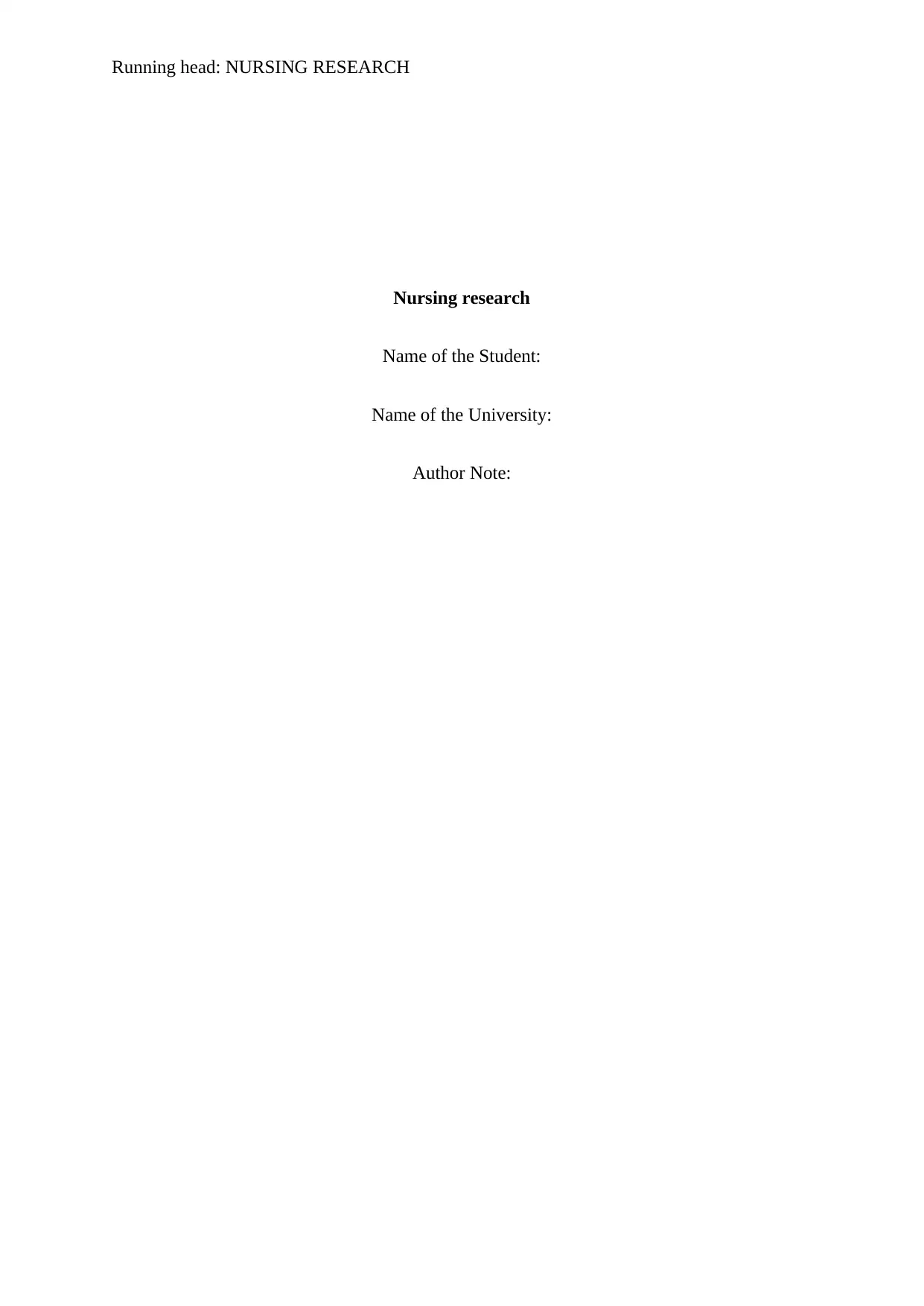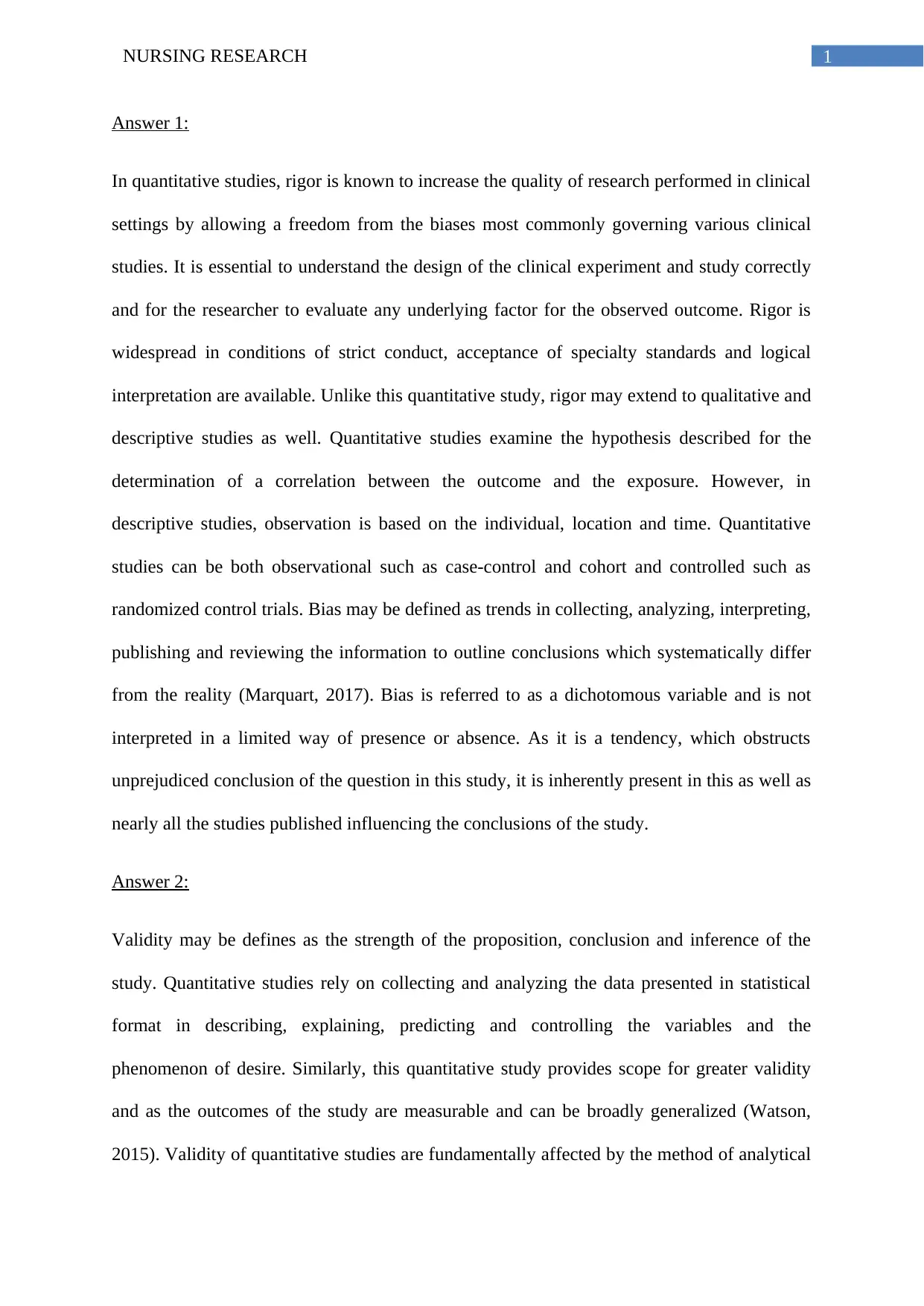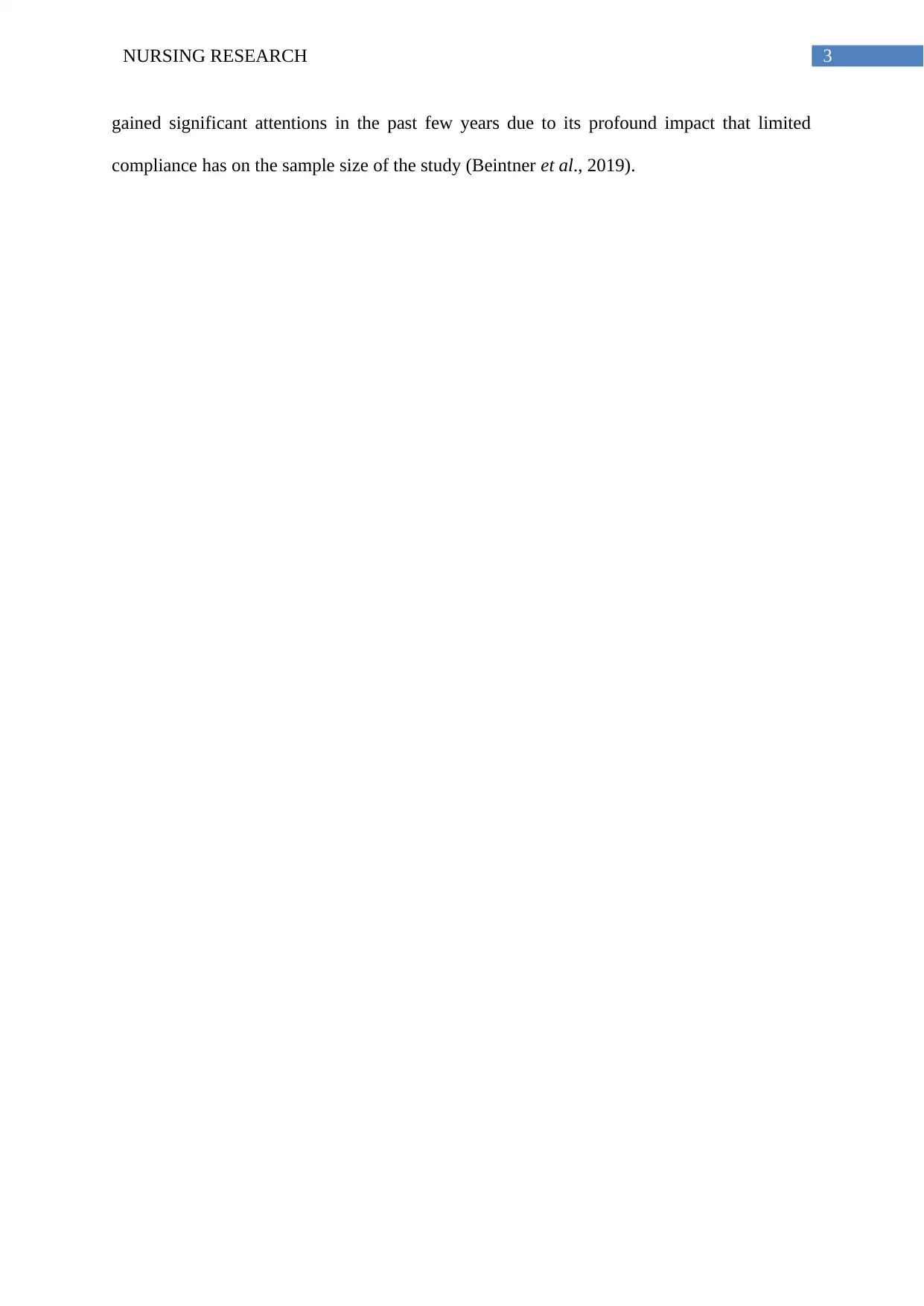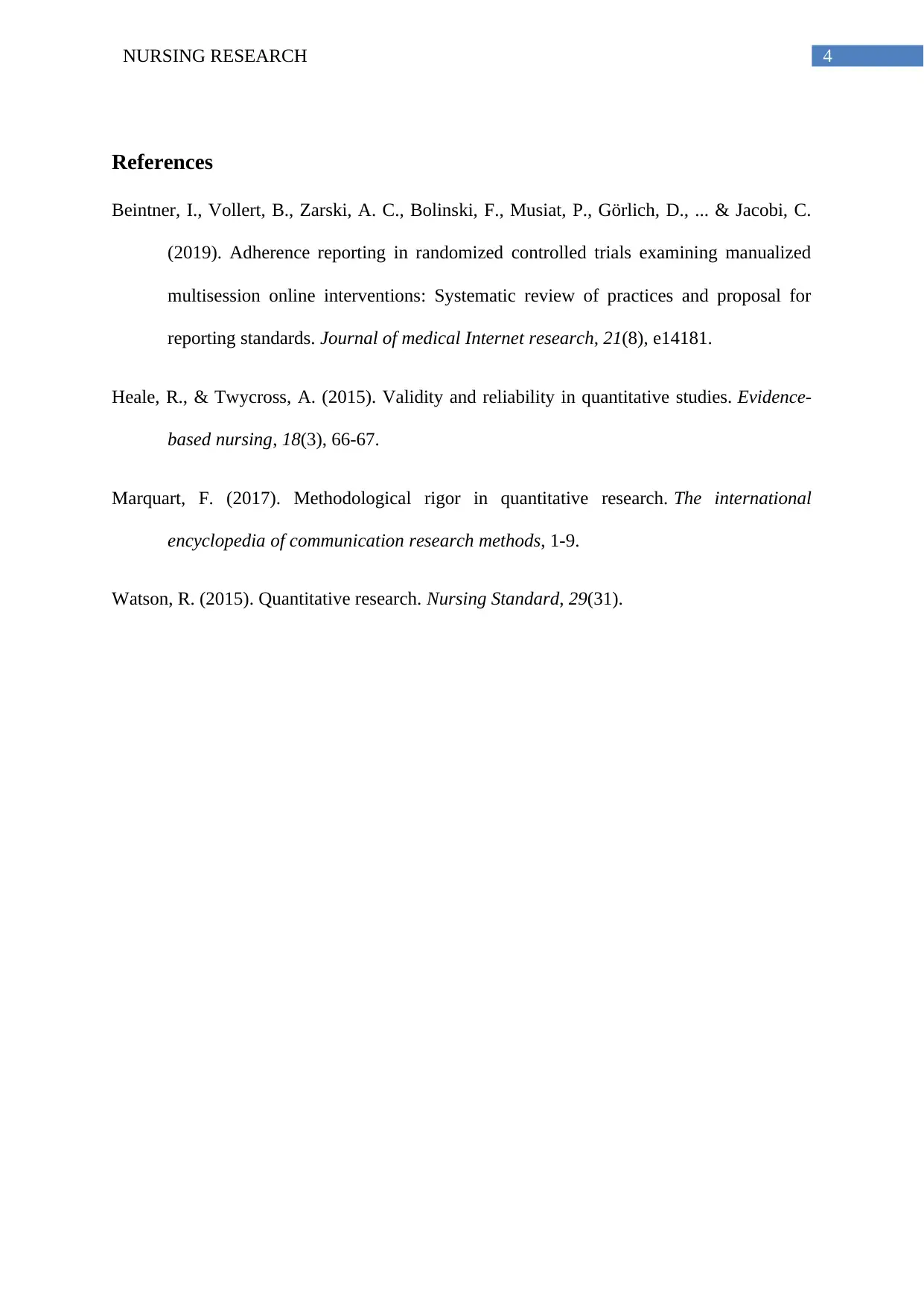Nursing Research: Evaluating Quantitative Research in Healthcare
VerifiedAdded on 2022/08/25
|5
|891
|23
Homework Assignment
AI Summary
This nursing research assignment analyzes key aspects of quantitative studies, including rigor, validity, and adherence. The student's work addresses the importance of rigor in minimizing bias and ensuring the quality of research, particularly in clinical settings. The assignment defines validity as the strength of study propositions and conclusions, emphasizing the role of different validity types (conclusion, internal, construct, and external) in assessing the reliability and generalizability of research findings. It also examines the concept of adherence to interventions, highlighting its critical impact on study outcomes and the interpretation of results, especially in the context of quantitative studies. The assignment references relevant literature to support its claims, providing a comprehensive overview of the essential elements of conducting and evaluating quantitative research in healthcare.

Running head: NURSING RESEARCH
Nursing research
Name of the Student:
Name of the University:
Author Note:
Nursing research
Name of the Student:
Name of the University:
Author Note:
Paraphrase This Document
Need a fresh take? Get an instant paraphrase of this document with our AI Paraphraser

1NURSING RESEARCH
Answer 1:
In quantitative studies, rigor is known to increase the quality of research performed in clinical
settings by allowing a freedom from the biases most commonly governing various clinical
studies. It is essential to understand the design of the clinical experiment and study correctly
and for the researcher to evaluate any underlying factor for the observed outcome. Rigor is
widespread in conditions of strict conduct, acceptance of specialty standards and logical
interpretation are available. Unlike this quantitative study, rigor may extend to qualitative and
descriptive studies as well. Quantitative studies examine the hypothesis described for the
determination of a correlation between the outcome and the exposure. However, in
descriptive studies, observation is based on the individual, location and time. Quantitative
studies can be both observational such as case-control and cohort and controlled such as
randomized control trials. Bias may be defined as trends in collecting, analyzing, interpreting,
publishing and reviewing the information to outline conclusions which systematically differ
from the reality (Marquart, 2017). Bias is referred to as a dichotomous variable and is not
interpreted in a limited way of presence or absence. As it is a tendency, which obstructs
unprejudiced conclusion of the question in this study, it is inherently present in this as well as
nearly all the studies published influencing the conclusions of the study.
Answer 2:
Validity may be defines as the strength of the proposition, conclusion and inference of the
study. Quantitative studies rely on collecting and analyzing the data presented in statistical
format in describing, explaining, predicting and controlling the variables and the
phenomenon of desire. Similarly, this quantitative study provides scope for greater validity
and as the outcomes of the study are measurable and can be broadly generalized (Watson,
2015). Validity of quantitative studies are fundamentally affected by the method of analytical
Answer 1:
In quantitative studies, rigor is known to increase the quality of research performed in clinical
settings by allowing a freedom from the biases most commonly governing various clinical
studies. It is essential to understand the design of the clinical experiment and study correctly
and for the researcher to evaluate any underlying factor for the observed outcome. Rigor is
widespread in conditions of strict conduct, acceptance of specialty standards and logical
interpretation are available. Unlike this quantitative study, rigor may extend to qualitative and
descriptive studies as well. Quantitative studies examine the hypothesis described for the
determination of a correlation between the outcome and the exposure. However, in
descriptive studies, observation is based on the individual, location and time. Quantitative
studies can be both observational such as case-control and cohort and controlled such as
randomized control trials. Bias may be defined as trends in collecting, analyzing, interpreting,
publishing and reviewing the information to outline conclusions which systematically differ
from the reality (Marquart, 2017). Bias is referred to as a dichotomous variable and is not
interpreted in a limited way of presence or absence. As it is a tendency, which obstructs
unprejudiced conclusion of the question in this study, it is inherently present in this as well as
nearly all the studies published influencing the conclusions of the study.
Answer 2:
Validity may be defines as the strength of the proposition, conclusion and inference of the
study. Quantitative studies rely on collecting and analyzing the data presented in statistical
format in describing, explaining, predicting and controlling the variables and the
phenomenon of desire. Similarly, this quantitative study provides scope for greater validity
and as the outcomes of the study are measurable and can be broadly generalized (Watson,
2015). Validity of quantitative studies are fundamentally affected by the method of analytical

2NURSING RESEARCH
research adopted such as experimental, quasi-experimental, descriptive or relationship-based.
Validity of a study is determined by its four types, namely, conclusion validity, internal
validity, construct validity and external validity. Conclusion validity aims to determine the
relationship between the method and the outcome observed. Internal validity focuses on the
causal relation between the study and its outcome. Construct validity determines the
correlation between the operationalization of the concept and the causal relationship. Lastly,
external validity aims at the capacity of the study to be generalized with respect to the setting
and standards of study applied. Reliability, on the other hand, refers to the consistency or
degree of accuracy of the measurement or the method implemented in measuring the
outcome. In other words, it is a measure of the repeatability of a results of a study. In such
studies, sample population is chosen by a suitable sampling procedure. In general, the
minimal sample size of 30 is considered reliable. Sample sizes smaller than 30 are not
reliable in most of the cases. Moreover, large sample sizes are highly reliable and
generalizable which increases the validity of the study as well. In cases with considerable
small sample sizes, the researchers should be particular of the quality of the limited data
collected such that it can be generalized and provide sound validity (Heale & Twycross,
2015). Thus, in this study, validity is more significant than reliability as the instrument of
measurement does not have an essential part in determining the result.
Answer 3:
Adherence to the intervention refers to the degree to which the researchers involve or
experience with the content of the method proposed. It is an essential parameter and
neglecting to assess and report compliance interferes with the interpretation and conclusion of
the findings in the study. Compliance in quantitative studies has been reported as a consistent
problem irrespective of the process or method of design used. Compliance or adherence has
research adopted such as experimental, quasi-experimental, descriptive or relationship-based.
Validity of a study is determined by its four types, namely, conclusion validity, internal
validity, construct validity and external validity. Conclusion validity aims to determine the
relationship between the method and the outcome observed. Internal validity focuses on the
causal relation between the study and its outcome. Construct validity determines the
correlation between the operationalization of the concept and the causal relationship. Lastly,
external validity aims at the capacity of the study to be generalized with respect to the setting
and standards of study applied. Reliability, on the other hand, refers to the consistency or
degree of accuracy of the measurement or the method implemented in measuring the
outcome. In other words, it is a measure of the repeatability of a results of a study. In such
studies, sample population is chosen by a suitable sampling procedure. In general, the
minimal sample size of 30 is considered reliable. Sample sizes smaller than 30 are not
reliable in most of the cases. Moreover, large sample sizes are highly reliable and
generalizable which increases the validity of the study as well. In cases with considerable
small sample sizes, the researchers should be particular of the quality of the limited data
collected such that it can be generalized and provide sound validity (Heale & Twycross,
2015). Thus, in this study, validity is more significant than reliability as the instrument of
measurement does not have an essential part in determining the result.
Answer 3:
Adherence to the intervention refers to the degree to which the researchers involve or
experience with the content of the method proposed. It is an essential parameter and
neglecting to assess and report compliance interferes with the interpretation and conclusion of
the findings in the study. Compliance in quantitative studies has been reported as a consistent
problem irrespective of the process or method of design used. Compliance or adherence has
⊘ This is a preview!⊘
Do you want full access?
Subscribe today to unlock all pages.

Trusted by 1+ million students worldwide

3NURSING RESEARCH
gained significant attentions in the past few years due to its profound impact that limited
compliance has on the sample size of the study (Beintner et al., 2019).
gained significant attentions in the past few years due to its profound impact that limited
compliance has on the sample size of the study (Beintner et al., 2019).
Paraphrase This Document
Need a fresh take? Get an instant paraphrase of this document with our AI Paraphraser

4NURSING RESEARCH
References
Beintner, I., Vollert, B., Zarski, A. C., Bolinski, F., Musiat, P., Görlich, D., ... & Jacobi, C.
(2019). Adherence reporting in randomized controlled trials examining manualized
multisession online interventions: Systematic review of practices and proposal for
reporting standards. Journal of medical Internet research, 21(8), e14181.
Heale, R., & Twycross, A. (2015). Validity and reliability in quantitative studies. Evidence-
based nursing, 18(3), 66-67.
Marquart, F. (2017). Methodological rigor in quantitative research. The international
encyclopedia of communication research methods, 1-9.
Watson, R. (2015). Quantitative research. Nursing Standard, 29(31).
References
Beintner, I., Vollert, B., Zarski, A. C., Bolinski, F., Musiat, P., Görlich, D., ... & Jacobi, C.
(2019). Adherence reporting in randomized controlled trials examining manualized
multisession online interventions: Systematic review of practices and proposal for
reporting standards. Journal of medical Internet research, 21(8), e14181.
Heale, R., & Twycross, A. (2015). Validity and reliability in quantitative studies. Evidence-
based nursing, 18(3), 66-67.
Marquart, F. (2017). Methodological rigor in quantitative research. The international
encyclopedia of communication research methods, 1-9.
Watson, R. (2015). Quantitative research. Nursing Standard, 29(31).
1 out of 5
Related Documents
Your All-in-One AI-Powered Toolkit for Academic Success.
+13062052269
info@desklib.com
Available 24*7 on WhatsApp / Email
![[object Object]](/_next/static/media/star-bottom.7253800d.svg)
Unlock your academic potential
Copyright © 2020–2025 A2Z Services. All Rights Reserved. Developed and managed by ZUCOL.





